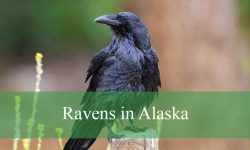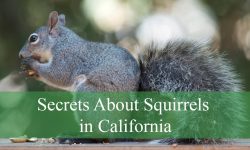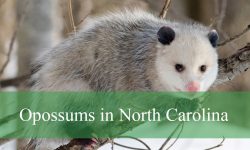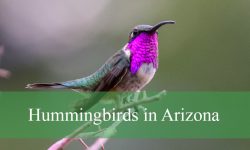In Florida, hummingbirds brighten the landscape with their brilliant colors and swift, fluttering wings. Despite their tiny size, these birds are full of life and charm, drawing the attention of birdwatchers and nature enthusiasts throughout the state.
Florida’s warm climate and diverse habitats provide an ideal home and stopover for a variety of hummingbird species. In this article, we’ll explore 12 hummingbirds you might see in Florida, complete with identification tips and pictures to help you spot these fascinating little birds in the wild or your own backyard.
Common Hummingbirds in Florida
Ruby-throated Hummingbird (Archilochus colubris)
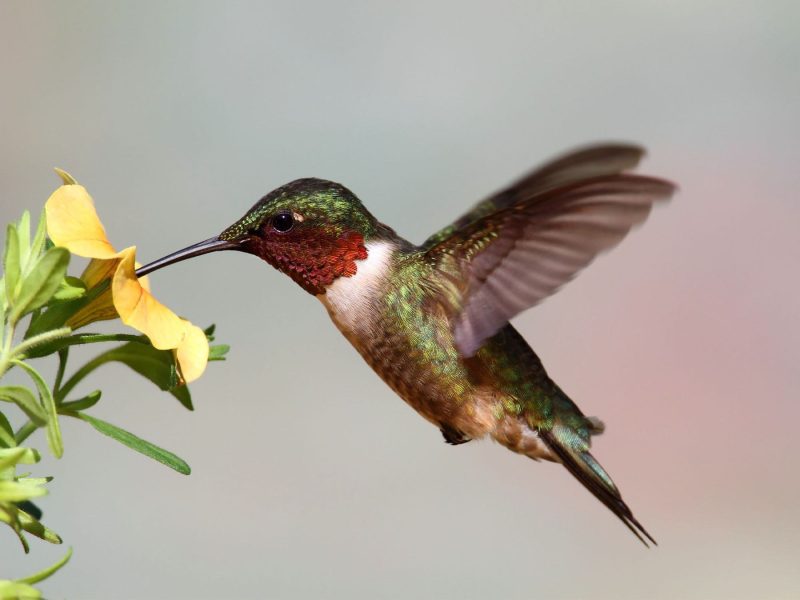
The Ruby-throated Hummingbird is the most common hummingbird in Florida and the only species that breeds regularly in the eastern United States. Males are instantly recognizable by their iridescent ruby-red throat, metallic green back, and white underparts, while females lack the red throat and have a more muted green coloration. These birds are tiny, measuring about 3 to 3.5 inches in length, with a wingspan of approximately 4 inches.
In Florida, Ruby-throated Hummingbirds are primarily found in gardens, woodlands, and meadows where flowering plants are abundant. They prefer areas with tubular flowers, which provide rich nectar, and are frequent visitors to backyard feeders. During migration, they pass through Florida in large numbers, making the state an important stopover point.
Their behavior is energetic and highly territorial. Males often chase other hummingbirds away from feeding areas, performing impressive aerial dives to defend their nectar sources. They also have a unique ability to hover in mid-air, thanks to rapid wing beats of around 50 times per second.
A fun fact about Ruby-throated Hummingbirds is their incredible migration journey. Many of them travel non-stop across the Gulf of Mexico, covering nearly 500 miles in a single flight, a remarkable feat for such a tiny bird.
Black-chinned Hummingbird (Archilochus alexandri)
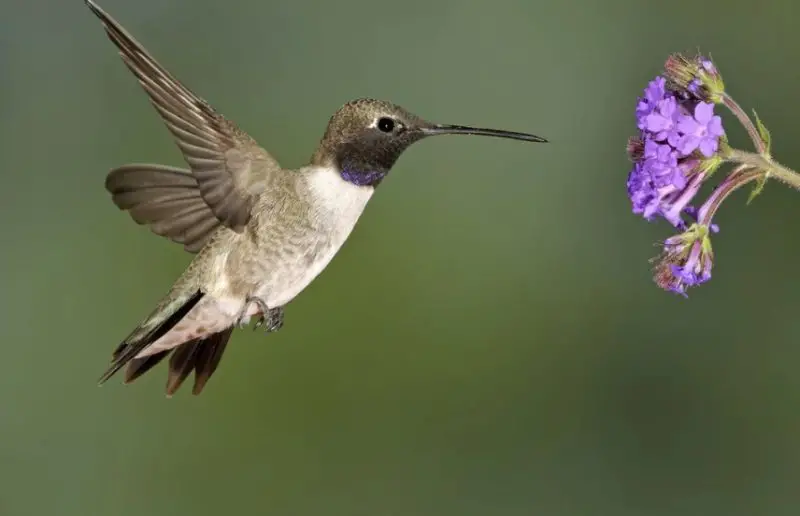
The Black-chinned Hummingbird is a rare visitor to Florida, but occasional sightings occur, especially during winter months. Males can be identified by their black throat with a thin, shimmering violet band at the base, which glows brilliantly in good light. Females and juveniles are mostly green on top and pale grayish-white underneath, making them less flashy than males. Adults measure around 3.25 inches in length with slender bodies and long, slightly curved bills.
In Florida, Black-chinned Hummingbirds are typically seen in coastal areas, gardens, and near wooded edges where nectar sources are available. They are not as common as Ruby-throated Hummingbirds but are sometimes drawn to feeders in the northern and central parts of the state.
Their behavior is slightly less aggressive than Ruby-throated Hummingbirds, but they still defend food sources when necessary. They are agile fliers, often performing quick, darting movements between flowers. Black-chinned Hummingbirds also consume small insects and spiders for protein, making them important insect controllers.
A fun fact about this species is their distinctive courtship display. Males perform dramatic pendulum-like dives while making a unique humming sound with their wings to attract females, a performance that highlights their agility and speed.
Rufous Hummingbird (Selasphorus rufus)
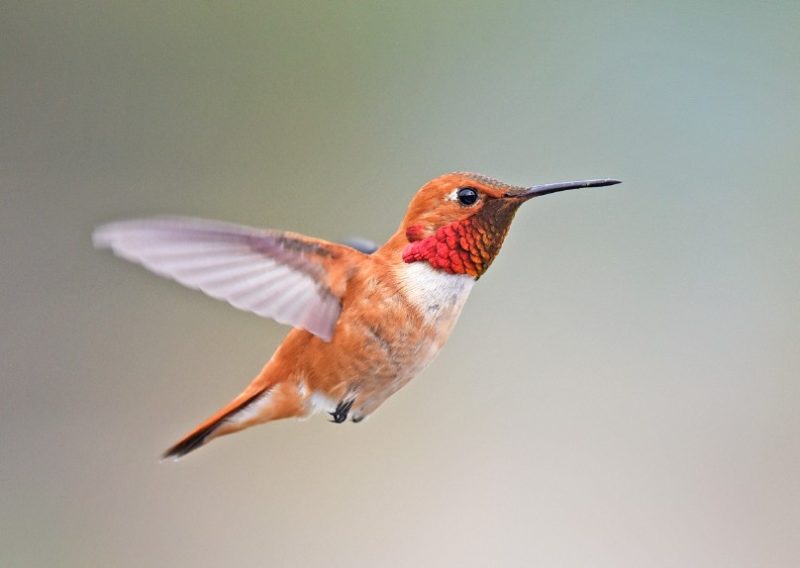
The Rufous Hummingbird is another rare but exciting hummingbird species to spot in Florida. Known for its brilliant rusty-orange plumage, males have a bright orange-red throat and coppery back, while females have greenish backs with rufous flanks and tail feathers. This species is slightly larger than some other hummingbirds, measuring about 3.5 to 4 inches long, with a wingspan up to 4.5 inches.
Rufous Hummingbirds are primarily seen in Florida during winter, as they migrate through the southeastern United States. They are often spotted in gardens, parks, and suburban areas where nectar feeders and flowering plants are available. Their adaptability allows them to visit human-inhabited areas more frequently than other rare species.
Behaviorally, Rufous Hummingbirds are known to be among the most aggressive hummingbird species. They fiercely defend feeding territories and often chase away larger birds. Their remarkable endurance also makes them one of the longest-distance migratory hummingbirds, traveling from as far as Alaska to Mexico.
A fun fact about Rufous Hummingbirds is their memory. They are known to remember individual gardens and feeders from previous migration seasons, often returning to the exact same spots year after year.
Buff-bellied Hummingbird (Amazilia yucatanensis)

The Buff-bellied Hummingbird is a rare visitor to Florida, typically seen in the southern parts of the state. It stands out with its shimmering green back, rusty-colored tail, and buffy underparts that give the species its name. Males have a bright iridescent green throat, while females are slightly duller but still striking. This species is larger than many other hummingbirds, measuring around 4 inches in length, with a strong, straight bill that is reddish at the base and black at the tip.
In Florida, Buff-bellied Hummingbirds are often spotted in coastal woodlands, gardens, and shrubby areas. They are more commonly observed near the Gulf Coast and are considered accidental or rare visitors during migration or in winter months.
Their behavior is relatively calm compared to more aggressive species like the Rufous Hummingbird. They feed on nectar from tubular flowers and are also known to catch small insects mid-air. Their feeding routine involves frequent hovering and rapid, darting flights between flowers and feeders.
A fun fact about Buff-bellied Hummingbirds is their unique vocalizations. Unlike the soft chirps of many hummingbirds, they produce a distinctive, sharp “tik” sound, which birdwatchers often use to identify them even before seeing them.
Calliope Hummingbird (Selasphorus calliope)
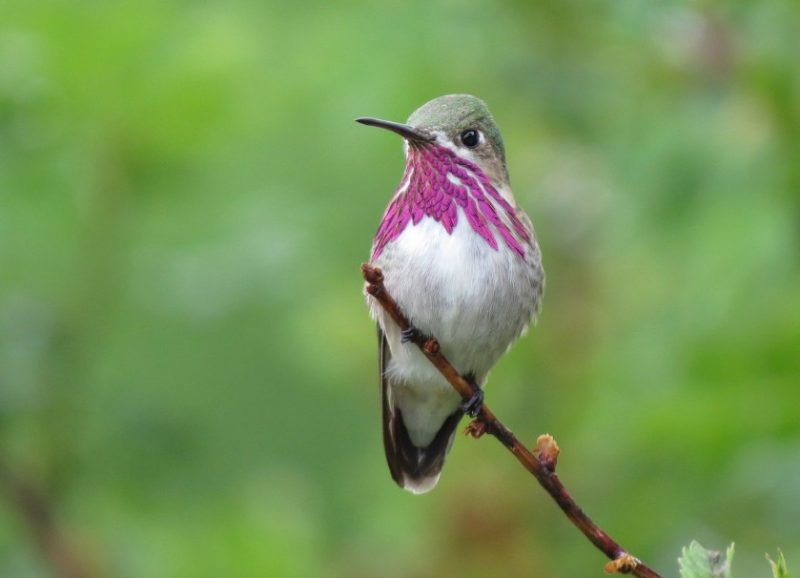
The Calliope Hummingbird is the smallest long-distance migratory bird in North America, and its rare presence in Florida excites birdwatchers. Males are striking with a brilliant magenta-streaked gorget arranged in streaks that fan out from the throat, contrasting with a white chest and greenish back. Females and juveniles are less colorful, displaying mostly green upperparts and whitish underparts with faint buffy sides. They are tiny, measuring only about 3 inches in length and weighing less than a penny.
In Florida, Calliope Hummingbirds are accidental visitors, usually appearing in winter months. They tend to visit gardens, parks, and wooded edges with flowering plants. Because of their size, they often go unnoticed unless carefully observed, and their rarity makes every sighting memorable.
Their behavior is surprisingly bold for such a small hummingbird. Calliope Hummingbirds defend feeding territories aggressively, often chasing larger hummingbirds away. They hover expertly, moving with rapid wing beats, and feed on both nectar and small insects.
A fun fact about Calliope Hummingbirds is their incredible migration journey. They travel thousands of miles between breeding grounds in the northwestern United States and wintering areas in Mexico, making them one of the longest-distance migrators relative to their tiny size.
Anna’s Hummingbird (Calypte anna)
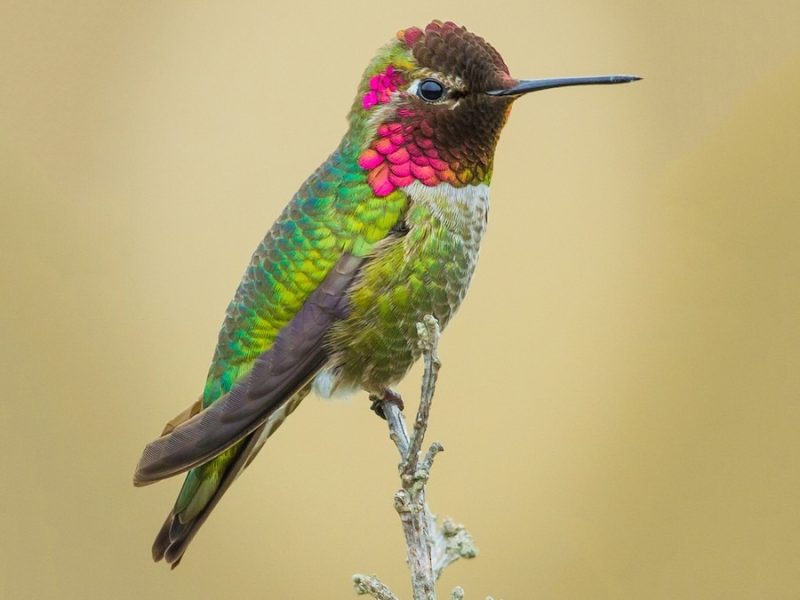
Anna’s Hummingbird, a dazzling species native to the West Coast, occasionally appears in Florida as a rare vagrant. Males are instantly recognizable by their vibrant rose-pink throat and crown, which shimmer brilliantly in sunlight, while females are mostly grayish-green with faint reddish spots on the throat. These medium-sized hummingbirds measure about 4 inches in length with a sturdy, straight bill.
In Florida, Anna’s Hummingbirds are typically reported in suburban gardens and parks, where feeders and flowering plants provide food. Sightings are rare and usually occur during winter, making them a prized observation for birdwatchers.
Their behavior is active and territorial, especially during breeding season. Males are famous for their dramatic courtship displays, flying high into the air before diving steeply while producing a sharp, loud sound created by their tail feathers. Even outside breeding season, they often perch conspicuously while guarding nectar sources.
A fun fact about Anna’s Hummingbirds is their adaptability to urban environments. On the West Coast, they are known to breed year-round, even in city gardens, and have expanded their range significantly in recent decades.
Costa’s Hummingbird (Calypte costae)
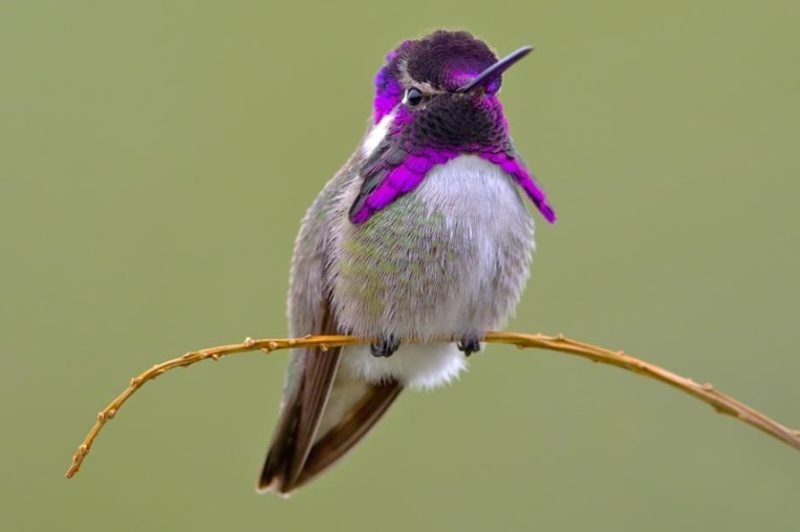
Costa’s Hummingbird, with its distinctive purple crown and long, flaring throat feathers, is a rare visitor to Florida but is occasionally spotted during migration or winter. Males are easily identified by their striking violet-purple gorget and crown, while females are mostly greenish-gray with a faintly speckled throat. These birds are small, measuring around 3.5 inches, and have a slightly shorter, stubbier appearance than other hummingbirds.
In Florida, Costa’s Hummingbirds are accidental visitors, most often recorded in gardens with abundant nectar flowers or feeders. They favor areas that mimic their native desert habitats, such as open scrubby landscapes or dry coastal regions.
Their behavior is lively and territorial, with males performing dramatic U-shaped courtship flights to impress females. Costa’s Hummingbirds also exhibit a unique hovering style, holding their position close to flowers with rapid, precise wing movements.
A fun fact about Costa’s Hummingbirds is their ability to thrive in arid regions. In their native range, they can survive long periods without rain by feeding on desert flowers and occasionally sipping dew for hydration, an unusual adaptation for hummingbirds.
Allen’s Hummingbird (Selasphorus sasin)
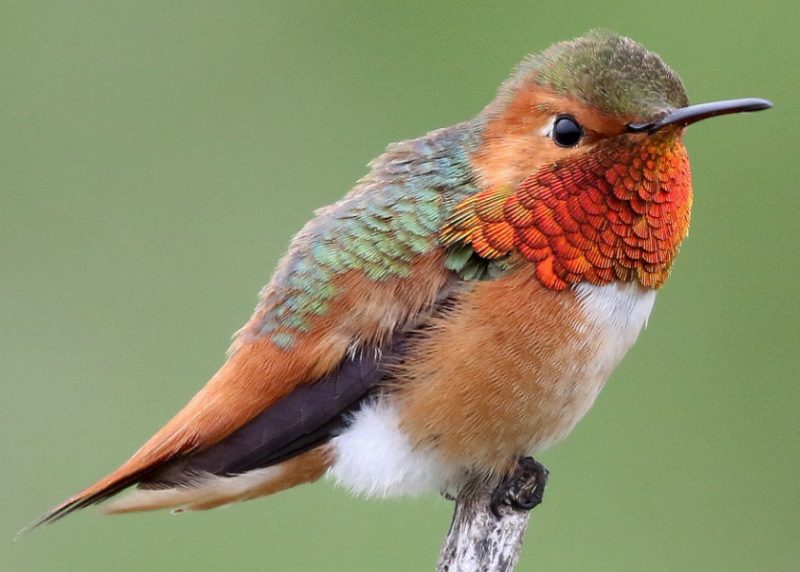
Allen’s Hummingbird, closely related to the Rufous Hummingbird, is another rare and exciting visitor to Florida. Males display a bright reddish-orange throat, coppery back, and greenish crown, giving them a stunning, fiery appearance. Females are greenish above with rufous sides and a lightly speckled throat. Their size is similar to the Rufous Hummingbird, measuring about 3.5 inches in length with a slender build.
In Florida, Allen’s Hummingbirds are seen mostly in winter months and are often confused with Rufous Hummingbirds. They frequent gardens, parks, and coastal scrublands where nectar-rich flowers or feeders are available. Birders carefully study their plumage and tail patterns to distinguish them from their close relatives.
Their behavior is energetic and aggressive when defending food sources. Males perform unique courtship dives, producing a buzzing sound with their wings to attract females. They are also adept at catching tiny insects in midair, supplementing their nectar diet.
A fun fact about Allen’s Hummingbirds is that they build remarkably delicate nests lined with spider silk and plant down, allowing the nest to stretch as chicks grow, a clever adaptation for such tiny birds.
Broad-tailed Hummingbird (Selasphorus platycercus)
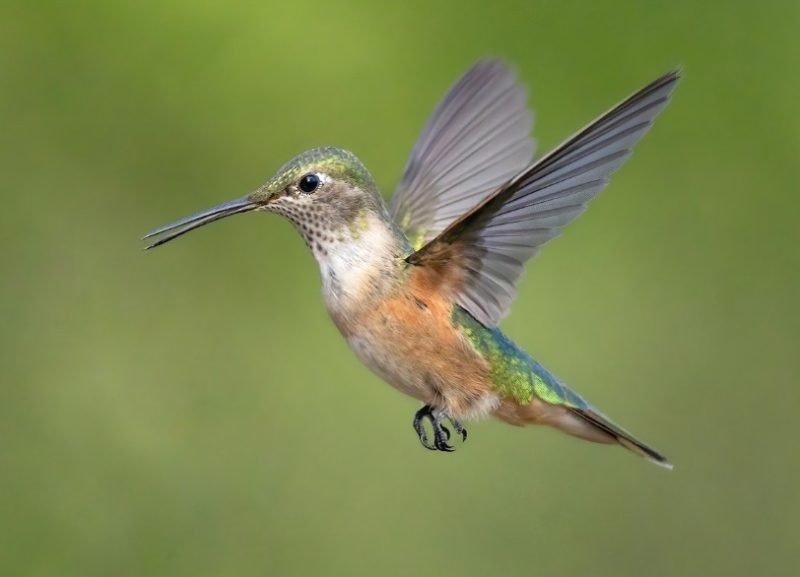
The Broad-tailed Hummingbird is an occasional winter visitor to Florida, admired for its distinctive metallic green back and rosy-pink throat patch found in males. Females and juveniles are less colorful, showing mostly green upperparts and pale underparts with light speckles on the throat. These hummingbirds are medium-sized, measuring about 4 inches long, with their name derived from their noticeably broad tail feathers edged in white.
In Florida, Broad-tailed Hummingbirds are rare but have been spotted in gardens and parks with flowering plants or nectar feeders, especially during migration seasons. They prefer open woodlands, meadows, and areas where flowers are abundant, often visiting suburban backyards when food sources are available.
Their behavior is energetic and highly vocal compared to other hummingbirds. Males produce a distinctive trilling sound with their wings during flight, a characteristic that makes them easy to identify even without visual confirmation. They are also territorial, often engaging in quick chases to defend nectar-rich flowers.
A fun fact about Broad-tailed Hummingbirds is their remarkable cold-weather adaptation. In their native mountainous habitats, they can enter a state of torpor, lowering their body temperature at night to conserve energy in chilly conditions, an ability not common among all hummingbird species.
Broad-billed Hummingbird (Cynanthus latirostris)
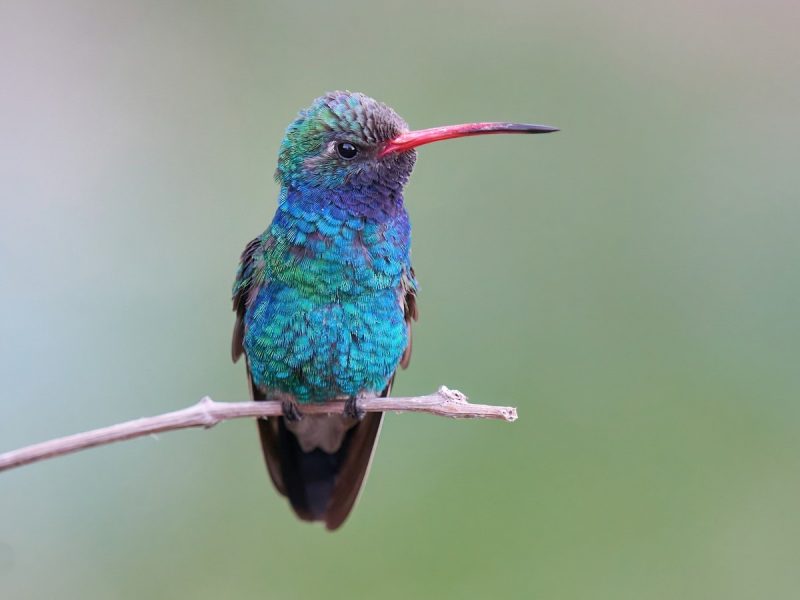
The Broad-billed Hummingbird is a striking, brightly colored species that occasionally makes its way to Florida as a rare vagrant. Males are stunning with glittering emerald-green plumage, a deep blue throat, and a long, bright reddish bill tipped with black. Females are less colorful, with a green back, pale grayish underparts, and a less vivid bill. These hummingbirds measure around 3.5 to 4 inches in length and have a slender, elegant appearance.
In Florida, Broad-billed Hummingbirds are rare but are occasionally recorded in southern parts of the state, particularly in gardens, parks, and areas with exotic flowering plants. They prefer habitats with dense shrubs or flowering hedges where nectar is plentiful.
Their behavior is active and somewhat less aggressive compared to species like the Rufous Hummingbird. They frequently hover in front of flowers, rapidly darting between feeding spots, and also consume small insects for protein. Broad-billed Hummingbirds are often attracted to brightly colored, tubular flowers, making them a delightful visitor to well-planted gardens.
A fun fact about Broad-billed Hummingbirds is their unique courtship display, where males fly in fast, looping patterns to impress females, often accompanied by soft, high-pitched vocalizations that are quite different from other hummingbirds’ sounds.
Bahama Woodstar (Nesophlox evelynae)

The Bahama Woodstar is an exceptionally rare hummingbird in Florida, with only a few recorded sightings, typically in the southernmost parts of the state. Males are striking with a metallic green back, rufous sides, and a sparkling violet throat that can appear blue in certain lighting. Females are less vibrant, with a duller green back and buffy underparts. They are small hummingbirds, averaging around 3 to 3.25 inches in length.
In Florida, Bahama Woodstars are accidental visitors, most likely blown off course from their native range in the Bahamas. Sightings typically occur in coastal gardens, parks, or natural areas where flowering plants and feeders provide reliable nectar sources.
Their behavior is shy compared to more aggressive species, often feeding quietly and retreating quickly into shrubs. They hover gracefully at flowers, making soft, high-pitched calls that are barely audible to human ears. Because of their rarity, spotting one in Florida is considered a special event among bird enthusiasts.
A fun fact about Bahama Woodstars is their significance in Bahamian culture, where they are sometimes referred to as “God birds” due to their delicate beauty and gentle presence, symbolizing peace and harmony.
White-eared Hummingbird (Basilinna leucotis)

The White-eared Hummingbird is an extraordinarily rare visitor to Florida, instantly recognizable by the bold white stripe running from behind the eye to the neck, which gives the species its name. Males have shimmering green plumage, a violet crown, and a reddish bill with a black tip, while females are duller with muted green tones and a less distinct facial pattern. Their size averages about 3.5 to 4 inches, with a sturdy, compact build.
In Florida, White-eared Hummingbirds are rarely recorded, with most sightings occurring in southern regions. They are typically found in gardens, parks, and subtropical forests with abundant nectar sources. Their rarity makes them a highly sought-after species for birdwatchers.
Their behavior is active but generally non-aggressive, making them less territorial than some other hummingbirds. They hover gracefully at flowers and feeders, moving swiftly but without the intense chasing commonly seen in species like Rufous Hummingbirds.
A fun fact about White-eared Hummingbirds is their adaptability to different elevations in their native range, from lowland forests to mountainous regions. Their presence in Florida is often attributed to storms or unusual weather patterns carrying them far beyond their typical distribution.
FAQs About Hummingbirds in Florida
Are Hummingbirds Common in Florida?
Yes, hummingbirds are commonly seen in Florida, especially the Ruby-throated Hummingbird, which breeds regularly in the state. Other species, such as Rufous and Black-chinned Hummingbirds, are less common but can be spotted during migration or winter months.
When Is the Best Time to See Hummingbirds in Florida?
The best time to see hummingbirds in Florida is during spring and fall migration, as well as in late winter. Ruby-throated Hummingbirds are present almost year-round in some areas, while rare species are most often seen in winter.
What Flowers Attract Hummingbirds in Florida?
Flowers with tubular shapes and bright colors, such as hibiscus, trumpet vine, salvia, and coral honeysuckle, are highly attractive to hummingbirds. Native plants and nectar feeders can also encourage them to visit gardens frequently.
Are All Hummingbirds in Florida Native?
No, only the Ruby-throated Hummingbird is a regular breeding native in Florida. Most other species, including Rufous, Buff-bellied, and Calliope Hummingbirds, are considered rare visitors or accidental migrants.
Can I Attract Rare Hummingbirds to My Yard in Florida?
Yes, by planting nectar-rich flowers, providing sugar-water feeders, and maintaining a safe environment with shrubs for cover, you can attract both common and rare hummingbirds to your yard.
Conclusion
Florida’s hummingbirds, from the vibrant Ruby-throated to rare visitors like the Bahama Woodstar, bring life and color to gardens, forests, and coastal areas. Their dazzling plumage, fascinating behaviors, and incredible migrations make them some of the most exciting birds to watch. By creating hummingbird-friendly habitats, bird enthusiasts can enjoy close encounters with these stunning species while contributing to their conservation.

